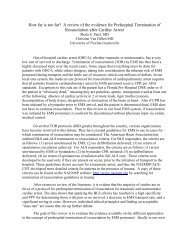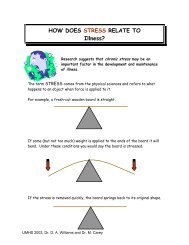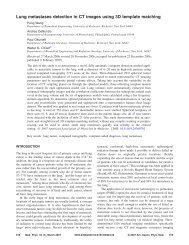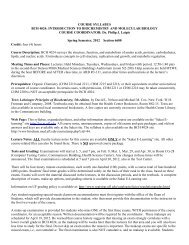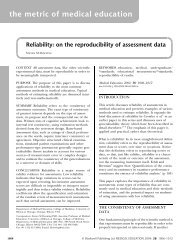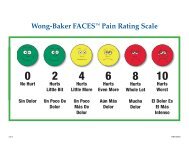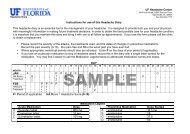imaging three-dimensional cardiac function - Walter G. O'Dell, PhD
imaging three-dimensional cardiac function - Walter G. O'Dell, PhD
imaging three-dimensional cardiac function - Walter G. O'Dell, PhD
You also want an ePaper? Increase the reach of your titles
YUMPU automatically turns print PDFs into web optimized ePapers that Google loves.
442 O’DELL MCCULLOCHAnnu. Rev. Biomed. Eng. 2000.2:431-456. Downloaded from arjournals.annualreviews.orgby UNIVERSITY OF ROCHESTER LIBRARY on 07/27/09. For personal use only.?a nonsymmetric 2-D displacement gradient tensor:by u x , then the displacement gradient is u x /x. The infinitesimal displacementgradient is δu x /δx. If a second degree of motion is added, along a y-axis, then thereis a potential for stretch or compression along this second axis and for rotationand/or shearing in the plane of motion. The complete 2-D motion is described by⎡∂u x∇U = ⎢ ∂x⎣ ∂u y∂x⎤∂u x∂y⎥∂u y⎦∂yAt least <strong>three</strong> points are required to fully describe all of these potential motions inthe neighborhood of a material point. Rigid-body rotations alter the displacementgradient component values, and therefore a rotation-invariant measure of deformationis generally preferred. One such measure is the Lagrangian strain tensor,E, computed asE = 1 2 [(∇U)T × (∇U) {+} (∇U) T {+} (∇U)]Chen et al (52) and Young & Hunter (48) incorporated both surface geometrydata and coronary tree bifurcation points to model epicardial motion and strains.McEachen & Duncan (54) used points of curvature extrema similarly. These methodsused the tracking of these identifiable surface points along with smoothingconstraints to estimate surface point trajectories. For investigational use, Arts et al(55) implanted a total of 14 radiopaque surface markers around the heart and computedcoefficients in a 14-parameter kinematic model of heart motion. Clinically,similar studies with transplanted hearts embedded with tantalum helices have beenperformed by Moon et al (56) and Hansen et al (57), yielding similar results. Thesparseness of the material markers in these studies severely limited the accuracyand application of these methods for strain calculation (6), yet they provided novelshape and shape-change information (50, 58). In canine hearts, Hashima et al (59)achieved much greater material point density by sewing 25 lead beads into theLV free wall. The resulting finite element-derived, nonhomogeneous epicardialstrains showed substantial alteration during occlusion of the left anterior descending(LAD) coronary artery, compared with the nonoccluded state. Nevertheless,the absence of material points within the myocardium limits the conclusions thatcan be drawn from such surface analyses.To compute a local 3-D displacement gradient tensor requires a minimum offour noncoplanar material points (60). The magnitude and rate of change of thesedeformations vary regionally around the heart and throughout the <strong>cardiac</strong> cycle. Toaccurately assess 3-D <strong>cardiac</strong> <strong>function</strong>, one must first be able to define and track asufficient number of material points with adequate spatial and temporal resolution.Spatially, a complete description of the local strain requires a sampling intervalthat is sufficiently small to recover the smallest fluctuations in the motion field.Douglas et al (61) estimated, using spherical models and wall motion data from



